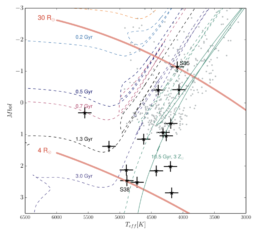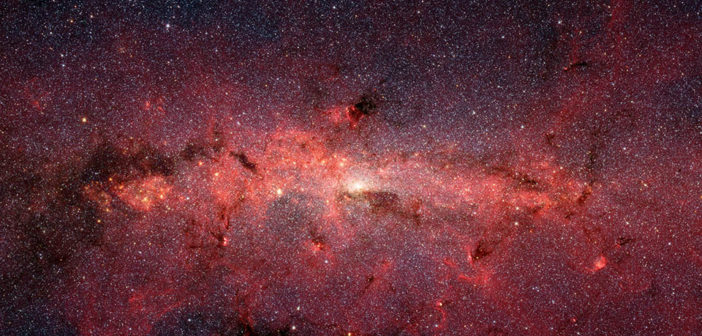How does a supermassive black hole affect its stellar neighbors? One way to explore this question is by searching for old, giant stars in the extreme environs of the galactic center.
Crowded Quarters

Dark dust lanes block the visible light from the galactic center, hiding the dense star cluster located there. [Dave Young]
Theory predicts that old, giant stars near the galactic center should be arrayed in a “cusp”-like distribution, with the number of stars per square arcsecond increasing sharply toward the central black hole. Faint red giants seem to follow the expected distribution, but brighter red giants — which can be probed closer to the center of the galaxy — do not. Instead, these stars appear to follow a “core”-like distribution, with fewer stars than expected within the central arcsecond of the galaxy.
Many theories have been proposed to explain the apparent lack of bright red giants near the galactic center, from stellar collisions to tidal disruption by the supermassive black hole. While these factors may play a role, it’s also possible that observational challenges have prevented astronomers from fully cataloging the stellar population at the galactic center.

Giant stars from this study (black stars) on an H-R diagram with the theoretical isochrones used to determine the stellar ages. [Habibi et al. 2019]
Tracking Down Missing Stars
Observing stars so close to the galactic center is tricky — it’s crowded there, and starlight is highly extincted by dust clouds in the galactic plane at many wavelengths. In order to probe the stellar population near the galactic center, a team led by Maryam Habibi (Max Planck Institute for Extraterrestrial Physics, Germany) analyzed more than a decade’s worth of near-infrared stellar spectra from the SINFONI spectrograph on ESO’s Very Large Telescope.
The spectra used in this study were collected with the help of adaptive optics, in which the telescope’s mirror is deformed slightly to correct for the effects of turbulence in Earth’s atmosphere in close to real time — critical for observations of individual stars in a field as crowded as the galactic center!
By co-adding multiple epochs of spectra to tease out faint spectral features, the authors derived the effective temperature, spectral type, age, mass, and radius for each target star. Their deeper spectra allowed them to identify old giants that had previously been misclassified as younger stars, bringing the number of known giants to 21.

Observed stellar density profiles from this and other studies of the galactic center. Previously, the observed distribution was consistent with a core-like profile (blue dashed line). The inclusion of the newly identified giants shows that the distribution is instead consistent with a cusp-like distribution. [Habibi et al. 2019]
Cusp Versus Core
Combining their new observations of bright giants within the central arcsecond with previously observed giants farther from the galactic center, the authors find that the distribution of bright giants can be described by a power law with an exponent of 0.34 ± 0.04 — definitively ruling out a core-like distribution.
Does this mean the galactic center’s core–cusp problem has been solved? While many of the missing giants have been found, the authors estimate that there are still stars awaiting discovery in the crowded interior of our galaxy, including some of the brightest red giants. Future observations should help us understand the complex distribution of stellar populations in the galactic center.
Citation
“Spectroscopic Detection of a Cusp of Late-type Stars Around the Central Black Hole in the Milky Way,” M. Habibi et al 2019 ApJL 872 L15. doi:10.3847/2041-8213/ab03cf


2 Comments
Pingback: AAS Nova – New
Pingback: Olbrzymie gwiazdy w sąsiedztwie naszej czarnej dziury – PTMA Kraków